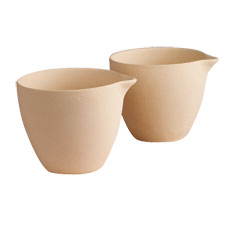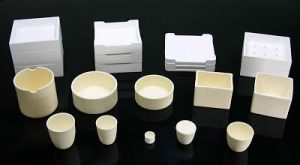- Alumina
- Boron Nitride
- Zirconia
- Other Ceramics
- Applications
- Contact

Ceramics melt at high temperatures and they exhibit a brittle behavior under tension. As a result, the conventional melting, casting and thermo-mechanical processing routes are not suitable to process the polycrystalline ceramics. Inorganic glasses, though, make use of lower melting temperatures due to formation of eutectics. Hence, most ceramic products are made from ceramic powders through powder processing starting with ceramic powders. The powder processing of ceramics is very close to that of metals, powder metallurgy. However there is an important consideration in ceramic-forming that is more prominent than in metal forming: it is dimensional tolerance. Post forming shrinkage is much higher in ceramics processing because of the large differential between the final density and the as-formed density.

Glasses, however, are produced by heating the raw materials to an elevated temperature above which melting occurs. Most commercial glasses are of the silica-soda-lime variety, where silica is supplied in form of common quartz sand, soda (Na2O) in form of soda ash (Na2CO3) while the lime (CaO) is supplied in form of limestone (CaCO3). Different forming methods- pressing, blowing, drawing and fiber forming- are widely in practice to fabricate glass products. Thick glass objects such as plates and dishes are produced by pressing, while the blowing is used to produce objects like jars, bottles and light bulbs. Drawing is used to form long objects like tubes, rods, fibers, whiskers etc.

Ceramic powder processing consists of powder production by milling/grinding, followed by fabrication of green product, which is then consolidated to obtain the final product. A powder is a collection of fine particles. Synthesis of powder involves getting it ready for shaping by crushing, grinding, separating impurities, blending different powders, drying to form soft agglomerates. Different techniques such as compaction, tape casting, slip casting, injection molding and extrusion are then used to convert processed powders into a desired shape to form what is known as green ceramic. The green ceramic is then consolidated further using a high-temperature treatment known as sintering or firing.
For more information, please visit http://www.samaterials.com/152-ceramic-material